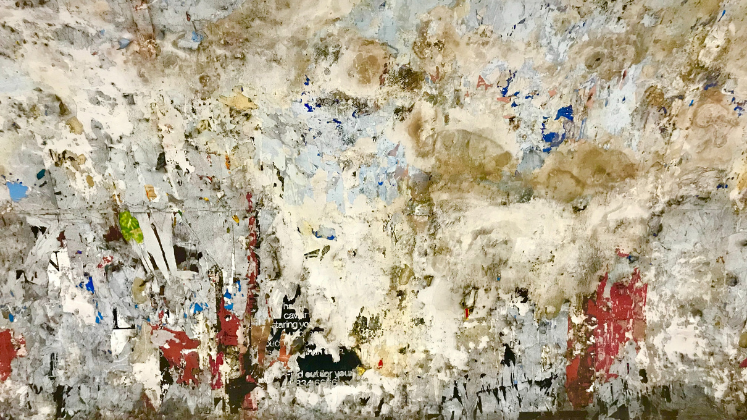In Decay, Ghassan Hage brings together contributors to explore the mechanisms, conditions and temporalities of social and material decay in a variety of settings across the globe. Encouraging new ways of thinking about social change and the relationship between perpetuation and transformation, these essays are provocative, imaginative and stimulating in their research, finds Helen Mackreath.
Decay. Ghassan Hage (ed.). Duke University Press. 2021.
 Find this book (affiliate link):
Find this book (affiliate link): ![]()
‘The mood of our time is depressive, and we are more likely to hear of social, moral, and urban, not to mention ecological, degradation, decline, and atrophy than the contrary,’ (1) writes editor Ghassan Hage in the introduction to the new collection, Decay. The book is published amidst a sense of futurelessness caused by epidemics and climate disasters, renewed political and intellectual attention to our collective relationship to mortality and the unavoidable fact that ‘everything decays’. These collected essays harness this bleak ‘structure of feeling’, in the words of Raymond Williams (2), as a socio-analytical starting point. As such, they occupy the vast space of the ‘open-ended dialectic between the decomposition of old life-forms and the composition of new ones’.
The concept of ‘decay’ adds ambiguity to this space, in part because of the inconsistent relationship between decay and mortality which ‘opens the imagination to the figure of the not-yet-dead, or, more ominously, the zombie, the figure of the should-be-dead-but-isn’t’ (4). This zombification is arguably most clearly manifested in the capitalist system, which is ‘increasingly rotting and decomposing’ yet seemingly ‘able to last in such a decomposed state forever’ (5). Decay, Hage argues, also necessarily haunts any social theory which engages with ‘the way things perpetuate themselves’ (following Spinoza’s concept of conatus). ‘It takes a particular form of blindness to see the present as pregnant with the “not-yet-born” without also noting that it is equally pregnant with the “not-yet-dead”,’ Hage writes (9).
This pragmatic starting point is put to work across a ‘terrain located between decay as a condition of the social, and decay as a history or a materialization of this condition’ (10). The collection includes eleven ethnographically informed essays, ranging from topics such as the ungovernability of waste and the maintenance of infrastructure to anti-migrant racism and the reproduction of an ever-decaying carceral society. The mechanisms, conditions and temporalities of decay are analysed in settings such as Australia, where the discourse of decay has been deployed by the government to legitimise punitive interventions and further attempts at assimilationist politics in First Nation communities; and in Macedonia where a variety of modes of talking with and against decay is reflected in the frequently used phrase se krpime (‘we stitch along’), which ‘intensifies the feeling of being in a perpetual state of falling apart’ (26).

Photo by Gavin Biesheuvel on Unsplash
In light of the collection’s varied engagements, it is instructive to ask what conceptual work is done by decay, different from that of ruin, precarity or mortality itself, which may encourage new ways of thinking about, among other things, social change and relationality.
Hage alludes to the particular socio-analytical purchase of ‘decay’ in his essay about the ‘fantasy of the defeated warrior’ among the ex-militiamen of the Lebanese civil war. He argues that their ‘discourse of defeat ends up having a positive anti-decaying function’ (122), acting as a means of maintaining their viability and status and ultimately their ability to ‘sustain the self’. Hage counter-poses ‘ruin’ and ‘decay’ through discussing Ann Laura Stoler’s essay ‘Imperial Debris’ in which she analyses the trail of ruin that colonialism left behind. ‘It is interesting that [while Stoler] encounters the stench of decay in many places, her gaze at them from a ruins perspective reduces them to precisely that: ruins without the sensory and affective dimension that is attached to them’ (124). Hage calls instead for a ‘disgusted ethnography’, which ‘would have to capture decay, bodily and sensually […] not only to analyze and intellectualize the social injustice that lies within this decay but also to […] experience its stench and feel the disgust’ (126).
Elsewhere various delineations of decay, degradation and dilapidation are carefully teased out as a means of demonstrating their potential for cynical political manipulation. Michael Herzfeld’s essay on urban decay in Rome details the clash between the so-called ‘romantic ruination’ of ‘heroic grandeur’ and imagined signs of ‘moral corruption’ which energise the complaints of ‘discontented citizens’. He argues that ‘the charge of degrado (degradation) has become a general expression of dissatisfaction with the sense of physical and moral collapse in society at large […] It is a sign of a lost battle to maintain the impoverished elegance of the ancient imperial capital. Moreover, it has acquired unpleasantly racist implications’ (62). This constructed threshold is entirely political, based on competing imaginations of the social, the public and what counts as ‘decay’.
When is the romantic ruin reconceptualised as degrado? Is it when it has fallen so far into ruins that there is no hope of recovering any sense of its ancient appearance? Is it when the graffiti scrawled on its antique walls usurp the role of officially regulated decay? (64)
Herzfeld’s explanation of the messy boundary between the conservative tendency towards ‘controlled decay’ and racist disgust at an imagined ‘uncontrolled’ degradation (Herzfeld suggests that this racism ironically represents the ‘true’ social decay) raises a point present throughout several essays. This is the ambiguous tension between the resistance, maintenance, management and deliberate production of ‘decay’, and who has control over this. Several contributions describe the manipulation of decay as a means of governmental control through a ‘let them decay’ colonial mentality. Elise Klein details the processes through which ‘the Australians turn decay into a characteristic of the Indigenous people themselves’ (14) as a justification for assimilationist politics. Cameo Dalley describes relational decay which is ‘rooted in historical settler colonial relationships and symptomatized in socio-spatial distributions of people’ (15). Tamara Kohn discusses ‘how decay, mold and rot are produced, interacted with and resisted’ (15) by people serving life sentences in US maximum security prisons. These essays are rich ethnographic accounts of the multilayered and often insidious workings of colonial forms of power.
The ‘structures, institutions, assemblages and forms of labour whose function is maintenance’ (11), explored by Akhil Gupta in relation to infrastructure, open up a different terrain of thinking. Gupta argues that ‘attention to maintenance allows us to conceptualize the work of repair as a creative and critical function that enables innovation and discovery so that infrastructures can function even as they degrade’. He also acknowledges that ‘we must see how maintenance may serve to exacerbate existing inequalities’ (45). The important work of maintenance is also present in Hage’s argument that social fantasies function as ‘maintenance mechanisms’ that work at slowing the decay of the social subject.
The fine distinctions and contradictions between repair and maintenance may also be what gives ‘decay’ different conceptual possibilities to the fertile ground covered by scholarship on death. A long history of various strands of research has theorised the political implications of our collective relationship with mortality – for instance, Achille Mbembe’s theory of necropolitics that argues that ‘turning a body into a corpse and a territory with its rivers, forests and biological life into ‘‘dead spaces’’ is perhaps the real nature of sovereignty’, or the concept of necrocapitalism, which emphasises capitalism’s increased profitability through the control and regulation of death. However, our relationship as political subjects with decay has largely been left unconsidered.
This may reflect the ambivalent political implications of foregrounding decay as a socio-analytical concept. A strange figure of the ‘hopeful’ subject (or its opposite) emerges in several essays which confront the nuanced differences between resisting, pragmatically accepting or being consumed by decay. In his discussion of Macedonian workers in Skopjani, Fabio Mattioli argues that hope itself was a ‘seed of decay’, and that ‘hope for a better future had only led to more failures, deepening their sense of moral degradation’ (88):
Mattioli’s pessimistic, and arguably limited, conclusion about the damaging impact of hope contrasts with the form of ‘hope’ separately found by Hage among the self-serving myths of defeated ex-militiamen in Lebanon, whose fantasy of ‘defeated warrior’ status was ‘infinitely better than being an unemployed person with no social worth living on the margins of the spaces where economic and moral viability was constructed’ (122). It also diverges from the contribution by Kohn, which describes how Cush, an inmate on death row who had already served 28 years in solitary confinement, ‘reframed [imprisonment] as an active source of connection – to changing ideas about oneself and one’s relations with others’ (147). Cush’s reframing does not negate the violence and cruelty of the ‘decaying prison system’ nor romanticise his confinement, but rather highlights the possibility of quiet defiance to the ‘expectation of decay’. These distinctions may also reflect varying interpretations of decay (‘disintegration’ or ‘decomposition’ offer a slightly different understanding than the more visceral ‘putrefy’ or ‘fester’, which is different again from a sense of ‘stagnation’) and their attendant processes.
These multiplicities point to the complex entanglements of the material, social and symbolic forms of decay, which are rooted in particular socio-historical and political contexts – things decomposing from the inside and those disintegrating owing to external factors (natural or political); decay as observed from the outside and the rot experienced by people living through the process(es). These entanglements reveal both the potential and the limits of taking a relatively oblique concept like ‘decay’ as a starting point. While Hage’s call for a ‘disgusted ethnography’ demands an active response to halt decay and its attendant violence and social injustice, this disgust has the potential to be inadvertently misdirected or manipulated if social ‘decay’ can also be imagined as well as deliberately materially produced. As outlined in the volume, a particular social/moral construction of ‘decay’ can justify racist exclusion, while a deliberately produced material ‘decay’ can legitimise urban demolition. As a result, the work of repair ‘may function as much in defense as in resistance to antidemocratic and antihumanist projects’ (Steven Jackson, 2014).
Through such contradictions, Decay comprehensively reveals the often uncomfortable ambivalence and unequal differences in ‘the way things perpetuate themselves’ – sometimes through violence, fantasy, exploitation, blame, sometimes through the careful labour of maintenance, care and creativity. This ambivalence may be politically restrictive if it also obscures the question of the myriad ways things ‘transform’ themselves. The positioning of ‘decay’ as a socio-political, material and differential process, rather than a stagnant and permanent ‘condition’, is helpful for illustrating the co-constitutive relationship between the two processes of perpetuation and transformation.
Despite their pessimistic frame of reference, these essays in Decay provide an attractive opening invitation for further thought. Taking up the difficult task of uniting a disparate number of biological, physical, organisational, moral, political, personal and social concerns, they are provocative, imaginative and stimulating in their reach.
- This review first appeared at LSE Review of Books.
Please read our comments policy before commenting.
Note: This article gives the views of the author, and not the position of USAPP – American Politics and Policy, nor of the London School of Economics.
Shortened URL for this post: https://bit.ly/3Db2i6F
About the reviewer
Helen Mackreath – LSE Department of Sociology
Helen Mackreath is a PhD candidate in Sociology at LSE. Her research interests include race, capitalism and postcolonial theory in relation to migrants in Istanbul.






